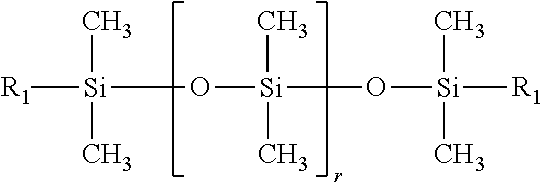Water-based inkjet ink
a water-based inkjet and inkjet technology, applied in the direction of inks, printing, duplication/marking methods, etc., can solve the problems of limited solvent and monomer use restrictions, poor wet spreadability of water-based inks, and low-absorption substrates, etc., to achieve excellent dischargeability, excellent storage stability, and high surface tension
- Summary
- Abstract
- Description
- Claims
- Application Information
AI Technical Summary
Benefits of technology
Problems solved by technology
Method used
Image
Examples
examples
[0134]The present invention is described below in further detail using a series of examples and comparative examples. In the following description, unless particularly stated otherwise, “parts”, “%” and “ratios” all represent weight-referenced values.
1. Pigment Dispersion Production Examples
[0135]Twenty parts of LIONOGEN BLUE FG-7358G (C. I. Pigment Blue 15:3, manufactured by Toyo Color Co., Ltd.) as a pigment, 15 parts of an aqueous solution (non-volatile fraction: 20%) of a styrene / acrylic resin (a random copolymer in which styrene:acrylic acid:behenyl methacrylate=35:30:35 (weight ratio), molecular weight: 16,000, acid value: 250) as a pigment dispersing resin and 65 parts of water were mixed, and a preliminary dispersion treatment was performed using a Disper. The aqueous solution of the styrene / acrylic resin was prepared using the method disclosed in Production Example 2 of the specification of JP 2012-188581 A.
[0136]Subsequently, the obtained mixture was subjected to a main di...
examples 1 to 82
, Comparative Examples 1 to 4
(1) Ink Composition Production Examples
Production Example for Inks 1C, 1M, 1Y, 1K
[0169]Twenty parts of the cyan pigment dispersion 1, 25 parts of 1,2-butanediol and 1 part of 2,5,8,11-tetramethyl-6-dodecyne-5,8-diol were added sequentially to a mixing container, sufficient water was then added to make the total ink amount up to 100 parts, and the resulting mixture was stirred until uniform with a Disper. Subsequently, the obtained mixture was filtered through a membrane filter having a pore size of 1 μm to remove coarse particles that can cause head blockages, thus obtaining an ink 1C.
[0170]With the exception of using the yellow pigment dispersion 2, the magenta pigment dispersion 3 and the black pigment dispersion 4 respectively instead of the above cyan pigment dispersion 1, inks 1Y, 1M and 1K were obtained in exactly the same manner as the ink 1C.
Production Examples for Inks 2 to 86
[0171]Using the formulations shown in Tables 2 to 7, the same method a...
PUM
| Property | Measurement | Unit |
|---|---|---|
| acid value | aaaaa | aaaaa |
| temperature | aaaaa | aaaaa |
| weight ratio | aaaaa | aaaaa |
Abstract
Description
Claims
Application Information
 Login to View More
Login to View More - R&D
- Intellectual Property
- Life Sciences
- Materials
- Tech Scout
- Unparalleled Data Quality
- Higher Quality Content
- 60% Fewer Hallucinations
Browse by: Latest US Patents, China's latest patents, Technical Efficacy Thesaurus, Application Domain, Technology Topic, Popular Technical Reports.
© 2025 PatSnap. All rights reserved.Legal|Privacy policy|Modern Slavery Act Transparency Statement|Sitemap|About US| Contact US: help@patsnap.com



